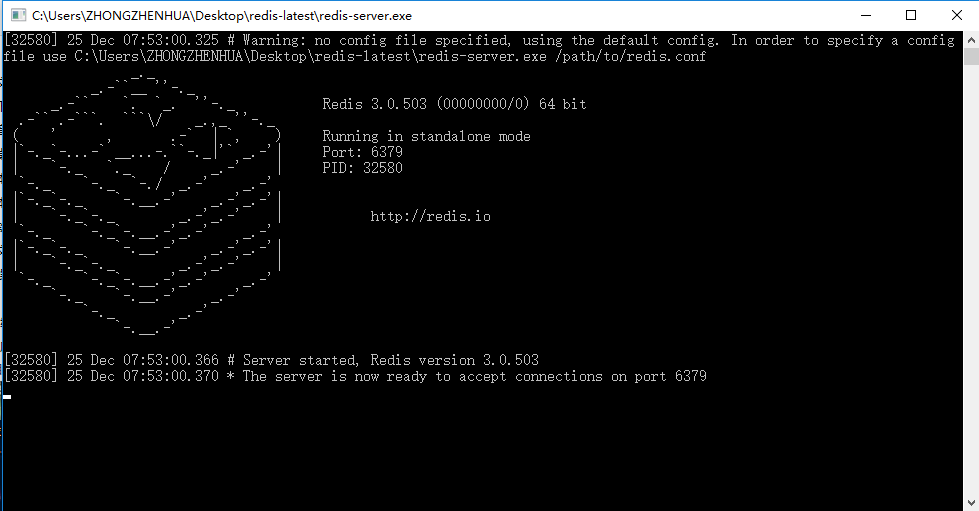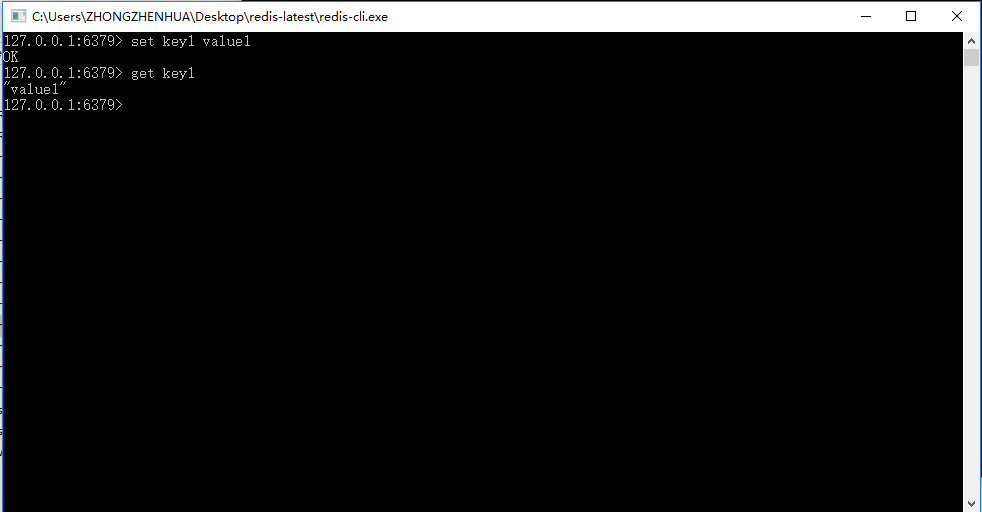第17章 Redis概述
17.2.1 在Windows下安装Redis
https://github.com/ServiceStack/redis-windows/tree/master/downloads

redis-server redis.windows.conf

17.3.1 在Java程序中使用Redis
http://mvnrepository.com/artifact/redis.clients/jedis/2.9.0
Java连接Redis
package com.ssm.chapter17.jedis;
import redis.clients.jedis.Jedis;
import redis.clients.jedis.JedisPool;
import redis.clients.jedis.JedisPoolConfig; public class JedisTest {
public void testJdedis(){
Jedis jedis = testPool().getResource(); //Jedis jedis = new Jedis("localhost", 6379);//连接Redis
//jedis.auth("password");//如果需密码 int i =0;//记录操作次数
try{
long start = System.currentTimeMillis();// 开始毫秒数
while(true){
long end = System.currentTimeMillis();
if (end-start >= 1000) {// 当大于等于1000毫秒(相当于1秒)时,结束操作
break; }
i++;
jedis.set("test" + i, i + "");
}
} finally{// 关闭连接
jedis.close();
}
System.out.println("redis每秒操作:" + i + "次");//打印1秒内对Redis的操作次数 }
}
使用Redis连接池
private JedisPool testPool(){
JedisPoolConfig poolCfg = new JedisPoolConfig();
// 最大空闲数
poolCfg.setMaxIdle(50);
// 最大连接数
poolCfg.setMaxTotal(100);
// 最大等待毫秒数
poolCfg.setMaxWaitMillis(20000);
// 使用配置创建连接池
JedisPool pool = new JedisPool(poolCfg, "localhost");
// 从连接池中获取单个连接
Jedis jedis = pool.getResource();
// 如果需密码
// jedis.auth("password")
return pool;
}
package com.ssm.chapter17.main;
import com.ssm.chapter17.jedis.JedisTest;
public class Chapter17Main {
public static void main(String[] args) {
testJedis();
}
private static void testJedis() {
JedisTest jedisTest = new JedisTest();
jedisTest.testJdedis();
}
}
17.3.2 在Spring中使用Redis
使用Spring配置JedisPoolConfig对象
<bean id="poolConfig" class="redis.clients.jedis.JedisPoolConfig">
<!-- 最大空闲数 -->
<property name="maxIdle" value="50"></property>
<!-- 最大连接数 -->
<property name="maxTotal" value="100"></property>
<!-- 最大等待时间 -->
<property name="maxWaitMillis" value="20000"></property>
</bean>
配置JedisConnectionFactory
<bean id="connectionFactory"
class="org.springframework.data.redis.connection.jedis.JedisConnectionFactory">
<property name="hostName" value="localhost"></property>
<property name="port" value="6379"></property>
<!-- <property name="password" ref="password"></property> --> <property name="poolConfig" ref="poolConfig"></property>
</bean>
配置Spring RedisTemplate
<bean id="jdkSerializationRedisSerializer"
class="org.springframework.data.redis.serializer.JdkSerializationRedisSerializer"></bean> <bean id="stringRedisSerializer"
class="org.springframework.data.redis.serializer.StringRedisSerializer"></bean> <bean id="redisTemplate" class="org.springframework.data.redis.core.RedisTemplate">
<property name="connectionFactory" ref="connectionFactory"></property>
<property name="keySerializer" ref="stringRedisSerializer"></property>
<property name="valueSerializer" ref="jdkSerializationRedisSerializer"></property>
</bean>
使用Redis保存角色类对象
package com.ssm.chapter17.pojo; import java.io.Serializable;
/**
* 注意,对象要可序列化,需要实现Serializable接口,往往要重写serialVersionUID
*
* @author zhongzh
*
*/
public class Role implements Serializable{ /**
*
*/
private static final long serialVersionUID = 6977402643848374753L; private long id; private String roleName; private String note; public long getId() {
return id;
} public void setId(long id) {
this.id = id;
} public String getRoleName() {
return roleName;
} public void setRoleName(String roleName) {
this.roleName = roleName;
} public String getNote() {
return note;
} public void setNote(String note) {
this.note = note;
} }
使用RedisTemplate保存Role对象
private static void testSpring() {
ApplicationContext applicationContext = new ClassPathXmlApplicationContext("applicationContext.xml");
RedisTemplate redisTemplate = applicationContext.getBean(RedisTemplate.class);
Role role = new Role();
role.setId(1L);
role.setRoleName("role_name_1");
role.setNote("role_note_1");
redisTemplate.opsForValue().set("role_1", role);
Role role1 = (Role) redisTemplate.opsForValue().get("role_1");
System.out.println(role.getRoleName());
}
使用SessionCallback接口
private static void testSessionCallback(){
ApplicationContext applicationContext = new ClassPathXmlApplicationContext("applicationContext.xml");
RedisTemplate redisTemplate = applicationContext.getBean(RedisTemplate.class);
Role role = new Role();
role.setId(1);
role.setRoleName("role_name_1");
role.setNote("role_note_1");
SessionCallback<Role> sessionCallback = new SessionCallback<Role>() {
public Role execute(RedisOperations ops)
throws DataAccessException {
// TODO Auto-generated method stub
ops.boundValueOps("role_1").set(role);
return (Role) ops.boundValueOps("role_1").get();
}
};
Role savedRole = (Role) redisTemplate.execute(sessionCallback);
System.out.println(savedRole.getId());
}
应改为:
private static void testSessionCallback(){
ApplicationContext applicationContext = new ClassPathXmlApplicationContext("applicationContext.xml");
RedisTemplate redisTemplate = applicationContext.getBean(RedisTemplate.class);
final Role role = new Role();
role.setId(1);
role.setRoleName("role_name_1");
role.setNote("role_note_1");
SessionCallback<Role> sessionCallback = new SessionCallback<Role>() {
public Role execute(RedisOperations ops)
throws DataAccessException {
// TODO Auto-generated method stub
ops.boundValueOps("role_1").set(role);
return (Role) ops.boundValueOps("role_1").get();
}
};
Role savedRole = (Role) redisTemplate.execute(sessionCallback);
System.out.println(savedRole.getId());
}
第17章 Redis概述的更多相关文章
- 第17章 中介者模式(Mediator Pattern)
原文 第17章 中介者模式(Mediator Pattern) 中介者模式 概述: 在软件开发中,我们有时会碰上许多对象互相联系互相交互的情况,对象之间存在复杂的引用关系,当需求更改时,对系统进 ...
- SSM框架学习笔记_第1章_SpringIOC概述
第1章 SpringIOC概述 Spring是一个轻量级的控制反转(IOC)和面向切面(AOP)的容器框架. 1.1 控制反转IOC IOC(inversion of controller)是一种概念 ...
- 第一章 数据库概述、MySQL的安装和配置
第一章 数据库概述.MySQL的安装和配置 1.为什么要使用数据库 最早是纸质文件来存储数据 缺点:不易保存,占用空间大 计算机出现以后,采用软件来进行保存(excel) 缺点:容易损坏 文件 ...
- Laxcus大数据管理系统2.0(2)- 第一章 基础概述 1.1 基于现状的一些思考
第一章 基础概述 1.1 基于现状的一些思考 在过去十几年里,随着互联网产业的普及和高速发展,各种格式的互联网数据也呈现爆炸性增长之势.与此同时,在数据应用的另一个重要领域:商业和科学计算,在各种新兴 ...
- CSS3秘笈第三版涵盖HTML5学习笔记13~17章
第13章,构建基于浮动的布局 使用的是float(浮动)属性 注:float:none值将取消所有浮动,通常只用来取消元素中已经应用的浮动. 切记:不需要给正文的div设计宽度,即使设计成固定宽度也不 ...
- 《深入Java虚拟机学习笔记》- 第17章 异常
<深入Java虚拟机学习笔记>- 第17章 异常
- JavaScript高级程序设计(第三版)学习笔记11、12、17章
章, DOM扩展 选择符 API Selector API Level1核心方法querySelector .querySelectorAll,兼容的浏览器可以使用 Document,Element ...
- C++ Primer Plus 文章17章 进,输出和文件
文章17章 进.输出和文件 1.当到达输入句子.他将刷新输出缓冲区满输出电流 2.streambuf分类 它提供了用于各种操作的一个缓冲 ios_base类表示流的一般特征 ios基础的类ios_ba ...
- 【RL-TCPnet网络教程】第17章 RL-TCPnet之UDP通信
第17章 RL-TCPnet之UDP通信 本章节为大家讲解RL-TCPnet的UDP通信实现,学习本章节前,务必要优先学习第16章UDP用户数据报协议基础知识.有了这些基础知识之后,再搞本章 ...
随机推荐
- [WIFI插座][阅读记录][SoC][RT5350] 00.目录 RALINK AP SDK 4.1.0.0 USER’s MANUAL
来源是CSDN,百度网盘下载地址 http://pan.baidu.com/share/link?shareid=3504767505&uk=3426044377 授权声明,略过 免责声明 ...
- (转)Bootstrap 之 Metronic 模板的学习之路 - (2)源码分析之 head 部分
https://segmentfault.com/a/1190000006684122 下面,我们找个目录里面想对较小的文件来分析一下源码结构,我们可以看到,page_general_help.htm ...
- C# MVC 返回html内容
var ss = Server.MapPath(""); //C:\Users\Administrator\Desktop\Csharp测试程序\TestMVC\TestMVC s ...
- Memcached 之缓存雪崩现象、实际案例和缓存无底洞现象
一.缓存雪崩现象 由于集群中某个memcached服务器宕机的原因,造成集群中的服务器命中率下降.只能通过访问数据库得到数据,是的数据库的压力倍增,造成数据库服务器崩溃.重启数据库还是会崩溃,但是数据 ...
- matlab学习下拉菜单Pop-Up Menu的基本用法
创建下拉菜单,修改string的属性,tag改为kj1,value值如果是1就显示第一行的sin(x),是几就显示第几行 %可以更改value值var=get(handles.kj1,'value') ...
- https证书安装无效的主要原因
https证书的作用是为了确认服务端身份,但网络上充满了无效的证书,浏览器对使用无效证书的访问,给出危险.不安全警告,将是否选择继续访问由用户选择,而大多数用户是无法区分这是配置还是真的存在安全问题. ...
- 用doxygen风格注释代码生成文档
目录 用doxygen风格注释代码生成文档 1. 说明 2. 具体操作 2.1 生成头部注释 2.2 安装doxygen 2.3 工程配置 3. 总结 用doxygen风格注释代码生成文档 1. 说明 ...
- [51Nod 1301] 集合异或和 (dp)
传送门 Solution 一道比较好的dp题 想了半天组合数QAQ 首先要知道的是 A<B一定是B有一位是1且A的这位是0且前面都相等 那么肯定是要枚举这一位在哪里然后求出方案数 方案数考虑类似 ...
- django-celery-win10
setting初始化: 定时任务 增加tasks 启动:
- STM32 HAL库的定时器中断回调函数跟串口中断回调函数
void HAL_TIM_PeriodElapsedCallback(TIM_HandleTypeDef *htim) { //添加回调后的程序逻辑 if (htim->Instance == ...
